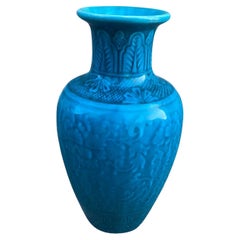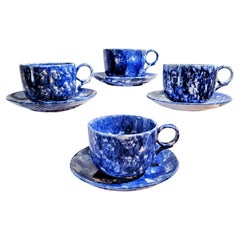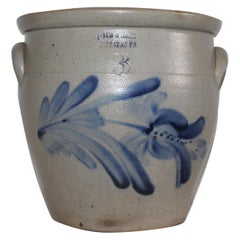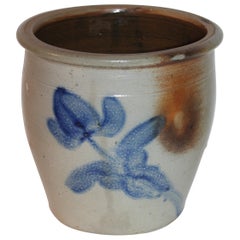Ceramics
Ceramics For Sale
Period: 19th Century
Color: Blue
Théodore Deck, Ceramic Vase, Signed, circa 1870
Located in Saint-Ouen, FR
Théodore Deck (1823-1891), ceramic vase, signed, circa 1870.
Category
Late 19th Century French Art Nouveau Antique Ceramics
Materials
Ceramic
19th C Sponge Mush Cups and Saucers, Set of Four
Located in Los Angeles, CA
This matching set of four 19thc sponge ware mush cups and saucers are in pristine condition.Many different shades of blues.Found in Pennsylvania private collection. Sold as a set of Four cups...
Category
Late 19th Century American Adirondack Antique Ceramics
Materials
Pottery
19th Century Lewis Jones Pittston Cobalt Blue Decorated Crock
Located in Los Angeles, CA
19th century Lewis Jones Pittston PA. Fine 3-gallon blue cobalt decorated stoneware crock. Stamped with maker’s mark. Hand Brisked cobalt floral decor...
Category
19th Century American Adirondack Antique Ceramics
Materials
Pottery
19thc Shenfelter Tulip Cobalt Blue 1 Galon Crock
Located in Los Angeles, CA
Antique Shenfelter In Redding PA, cobalt blue decorated crock Tulip design 1 Gallon. There is some burning during the making of this crock opposite of the Tulip.
Measures 8 x 8.5 ...
Category
Mid-19th Century American Adirondack Antique Ceramics
Materials
Pottery
Large 19th Century Flo Blue Soup Bowls in Watteau Pattern or Doulton
By Watteau Doulton
Located in Los Angeles, CA
Set of five flo blue soup bowls signed Watteau Doulton and in pristine condition. These English bowls are nice generous sizes.
Category
Mid-19th Century English American Classical Antique Ceramics
Materials
Pottery
Rare Collection of Six Matching 19th Century Spongeware Dinner Plates
Located in Los Angeles, CA
This is a collectors dream! Six matching blue and white matching sponge ware pottery dinner plates. They are all in pristine condition.
Category
Late 19th Century American Country Antique Ceramics
Materials
Pottery
Related Items
Rare Pair of 19th Century Meissen Nodding Pagodas
Located in Brighton, Sussex
A rare and fine quality pair of 19th century Meissen porcelain nodding Pagodas, each with wonderful bold coloured hand painted decoration, wit...
Category
19th Century German Antique Ceramics
Materials
Porcelain
Karos Hand Painted Carnations and Tulips Decorative Plate Rhodes Greece
Located in North Hollywood, CA
A decorative I Karos pottery, I Caro collector polychrome hand painted and handcrafted in Rhodes, Greece ceramic wall decorative plate with an antelope, carnations and tulip polychrome design.
The plate is decorated with a white, blue, aqua, green, and sienna red design and gilded with 24-karat gold.
These are intricately, hand painted plates made in Rhodes, Greece by the famous I Caro pottery.
Rhodes is famous for its kiln products, such as tiles and pottery, which are glazed and multicolored.
It has a beautifully hand painted carnation and tulip in burgundy, light and dark blue and turquoise foliage.
An Islamic ceramic plate in the Iznik style, painted in vivid colors with decoration of tulips and carnations.
The back of the plate is signed and numbered, it has a string to the back for hanging. It is marked
“handmade in Rhodes Greece by Ikaros Pottery...
Category
Mid-20th Century Greek Medieval Ceramics
Materials
Ceramic
Moroccan Ceramic Blue and Copper Urn with Lid
Located in North Hollywood, CA
Moroccan ceramic urn with lid, blue with copper color.
Modern form with clean lines, textured design.
Great to use in the kitchen or in the bath...
Category
Late 20th Century Moroccan Bohemian Ceramics
Materials
Ceramic
Robert Maxwell Signed Large Mid-Century Modern California Studio Pottery Charger
Located in Studio City, CA
A wonderfully made and beautifully designed Mid-Century Modern pottery charger by famed California potter and sculptor Robert Maxwell.
Maxwell co-founded Earthgender pottery with fellow potter David Cressey.
This charger/platter was made at his Venice beach, California Pottery studio in the early 1960s as verified by his wife. It is a very rare piece in respect to design, pattern, and sheer Size/heft (it is a very heavy work). We have not seen another quite like it.
Apparently, he only made a few with some filled with melted glass to create the design/pattern.
Signed by Maxwell on the base.
Would clearly be a great addition to any mid-century pottery/ceramics collection...
Category
1960s American Mid-Century Modern Vintage Ceramics
Materials
Pottery
H 1.5 in W 16.25 in D 16.25 in
A Théodore Deck (1823-1891) Enamelled Faience Soliflore Vase circa 1875
Located in Saint-Ouen, FR
Théodore DECK (1823-1891)
A polychromatic enamelled earthenware soliflore and quadrangular shape vase with Sino-Japanese inspiration design of flowers and geometrical friezes all around.
Impressed uppercase mark "TH.DECK" under the base.
Circa 1875
Born in Guebwiller in Alsace, Théodore Deck trained as a ceramist in his home region, then in Germany. He went into partnership with his brother, Xavier Deck, to create his own factory in Paris in 1858. At the Exhibition of Industrial Arts in 1864, he presented pieces covered with transparent enamels that were not cracked, and then made his first attempts at reliefs under transparent enamels. He developed a bright turquoise color, famously renowned as "Bleu Deck". It is this nuance that we find on the salamander represented on this vase. In 1887 he published a treatise entitled "La Faïence", in which he explained some of his discoveries. That same year, he became director of the Manufacture de Sèvres.
Theodore Deck (1823-1891) is a French ceramist born in Guebwiller in Alsace. He is passionate about chemistry and the physical sciences. In 1841, he joined the master stove maker Hügelin father as an apprentice in Strasbourg. In two years, he learned of the methods inherited from the 16th century, such as the encrustation of colored pastes in the style of Saint-Porchaire. This apprenticeship did not prevent him from spending his free time draw-ing or modeling clay in the studio of sculptor André Friederich. Escaping military service, he made a tour of Germany as is the tradition with fellow Alsatian stove-makers. The quality of his work allows him to obtain important orders in Austria for the castles of the provinces and the imperial palaces, in particular for the palace of Schönbrunn. He continues his journey in Hungary to Pest, to Prague, then, going north through Dresden, Leipzig, Berlin and Hamburg. On the strength of his apprenticeship, he arrived in Paris in 1847. Recommended by Hügelin, he went to the stove factory of the Bavarian potter Vogt, located rue de la Roquette. The Revolution of 1848 interrupts production and Deck decides to return to his hometown. His family then advised him to set up a small terracotta workshop: he made a few busts, statuettes, vases, lamps and copies of famous antiques there. Aware that this situation would not allow him to provide for himself properly, he returned to Paris in 1851 where he was employed by the widow Dumas, daughter of the earthenware maker Vogt for whom he had worked. Hired as a foreman, he supplied the drawings and models to the workers, while working the land himself.
The following year, he made the decision to settle not far from his former employer at 20, rue de la Fontaine-au-Roi, probably using his ovens. His brother, Xavier Deck, joins him. It was officially in 1858 that the Deck brothers created their business and settled in Paris at 46, boulevard Saint-Jacques. Initially, the brothers only carry out coatings for stoves. But the business is going so well that barely a year after their installation, they want to diversify their production and engage in ceramics for the cladding of buildings as well as in shaped parts. Deck is interested in politics. In 1870, he opted for French nationality and was elect-ed deputy mayor in the 15th arrondissement of Paris.
In 1861, at the Salon des arts et industries de Paris, which was held on the Champs-Élysées, Théodore Deck exhibited his works for the first time: these were pieces with an inlay decoration called “Henri II” and others. pieces covered with turquoise blue enamel or decoration in the style of Iznik ceramics.If he wins a silver medal, reviews are mixed, however. The following year, on the occasion of the Universal Exhibition of 1862 in London, he won over English customers. He surprised by presenting, like the previous year, his Alhambra Vase...
Category
1870s French Japonisme Antique Ceramics
Materials
Faience
H 10.63 in W 4.34 in D 4.34 in
Small Ceramic Blue and White Marbled Pinch Pot Vase
Located in Oklahoma City, OK
A beautiful small ceramic pinch pot vase. Created from clay, this fun piece will be fantastic used in a grouping of other vases and filled with your ...
Category
20th Century American Folk Art Ceramics
Materials
Ceramic
Ceramic Vase with White Glaze Decoration, Signed Lion, circa 1920-1930
By Eugène Lion
Located in Saint-Ouen, FR
A ceramic vase with white glaze decoration.
Perfect original conditions.
Signed "Lion" under the base,
circa 1920-1930.
Category
20th Century French Art Deco Ceramics
Materials
Ceramic
Charming Pair of Austrian 19th Century Polychromed Majolica Wall Sculptures
Located in Los Angeles, CA
A fine and charming pair of Austrian 19th century polychromed majolica hanging wall sculptures of an elderly couple peeking through a window, probably by Friedrich Goldscheider (Goldscheider'sche Porzellan-Manufactur und Majolica-Fabrik.) Each wall sculpture depicting an elderly man wearing glasses and a traditional cap with his arms extended forward as if it was reading a book or a newspaper. The other depicting an elderly lady, also peeking through a window, wearing a laced cap with a bow tie and shawl over her shoulders, her arms are also extended forward as if it was reading a book or a newspaper. The male figure stamped on the back "78 - II ." The lady figure stamped on the back "37 - 79." Vienna, circa 1890-1900.
Man's height: 16 1/2 inches (41.9 cm.)
Man's width: 13 3/4 inches (34.9 cm.)
Depth: 8 1/2 inches (21.6 cm.)
Lady's height: 15 1/2 inches (39.4 cm.)
Lady's width: 13 3/4 inches (34.9 cm.)
Lady's depth: 6 1/2 inches (16.5 cm.)
Goldscheider Manufactory and Majolica Factory (German: Goldscheider'sche Porzellan-Manufactur und Majolica-Fabrik, (now) Goldscheider Keramik) is an Austrian ceramic manufactory.
In 1885, Friedrich Goldscheider came from the small Bohemian city of Pilsen to Vienna and founded the Goldscheider Manufactory and Majolica Factory. It became one of the most influential ceramic manufactories of terracotta, faience and bronze objects in Austria with subsidiaries in Paris, Leipzig and Florence. For over half a century Goldscheider created masterpieces of historical revivalism, Art Nouveau (Jugendstil) and Art Deco. Famous artists such as Josef Lorenzl, Stefan Dakon, Ida Meisinger and the two perhaps best known Austrian ceramic artists Michael Powolny and Vally Wieselthier worked for Goldscheider. Several of the artists who worked for Goldscheider also worked for other Viennese studios, such as Augarten, Keramos or for the German brands Rosenthal and Meissen.
The Goldscheider family emigrated in 1938 to United Kingdom and USA. Walter Goldscheider startet a new factory in Trenton, New Jersey and returned to Vienna in 1950. Marcel Goldscheider went to Stoke-on-Trent and produced figurative ceramics for Myott and opened his own studio in the 1950s in Hanley. Both brothers died in the early 1960s.
More than 10,000 different models were created over a period of three generations. Since the very beginning many of these won first prizes and gold medals at innumerable world fairs, exhibitions and trade fairs. Goldscheider figures...
Category
Late 19th Century Austrian Baroque Antique Ceramics
Materials
Majolica
H 16.5 in W 13.75 in D 8.5 in
Large Moroccan Ceramic Vase from Fez with Blue Calligraphy Writing
Located in North Hollywood, CA
Large Moroccan glazed ceramic vase from Fez.
Moorish style ceramic handcrafted and hand painted with Arabic calligraphy writing.
This kind of Art Writing looks calligraphic is call...
Category
20th Century Moroccan Moorish Ceramics
Materials
Ceramic
Moroccan Ceramic Vase from Fez Blue and White with Silver Filigree
Located in North Hollywood, CA
Fabulous handcrafted antique Moroccan ceramic vase in Moorish style adorned with Fine filigree silver nickel work overlaid.
The color of...
Category
Mid-20th Century Moroccan Moorish Ceramics
Materials
Ceramic
Moroccan Blue & White Ceramic Footed Vase from Fez with Silver Filigree
Located in North Hollywood, CA
Antique Moroccan blue and white ceramic footed vase from Fez.
Moorish style handcrafted vase adorned with fine filigree silver nickel work, with two handles.
Antique Hispano Moresq...
Category
1890s Moroccan Moorish Antique Ceramics
Materials
Ceramic
Castelli Ceramic, Made in Abruzzo, Italy, 19th Century
Located in Roma, IT
This Castelli ceramic is a beautiful ceramic panel representing a religious scene, realized in 19th century.
In excellent condition, with vivid col...
Category
19th Century Italian Antique Ceramics
Materials
Ceramic
Previously Available Items
Théodore Deck, Ceramic Vase, Signed, circa 1870
Located in Saint-Ouen, FR
Théodore Deck (1823-1891), ceramic vase, signed, circa 1870.
Category
Late 19th Century French Art Nouveau Antique Ceramics
Materials
Ceramic
19th Century Blue Painted Redware Pottery Barrel Form Bank
Located in Essex, MA
A 19th century American blue painted red ware pottery barrel-form bank. With its beautiful color, patina and form, this ceramic coin bank is a beautiful...
Category
1880s American Country Antique Ceramics
Materials
Pottery
19th Century Sponge Ware Design Pattern Pitcher
Located in Los Angeles, CA
19th century sponge ware pottery pitcher in a design sponge pattern has a small chip on the inside lip. Rings like a bell with no cracks.
Category
Late 19th Century American Adirondack Antique Ceramics
Materials
Pottery
Recently Viewed
View AllMore Ways To Browse
Antique 1 Gallon Stoneware Crock
Mquan Wall Hanging
Robinson Ransbottom Cookie Jar
Lagardo Eggheads
Robinson Ransbottom Spongeware
Bisque Nodders
Adam And Eve Bed
Antique 2 Gallon Stoneware Jug
Crock 19th Century Cowden Wilcox
Native American Pottery Seed Bowl
Beatrix Potter Figurines Vintage
The Art Of Chokin
Flo Blue Soup Bowls
Japanese Chokin
American Sponge Ware Cup And Saucer
Chokin Art
Saran Dining Tables
Art Of Chokin









